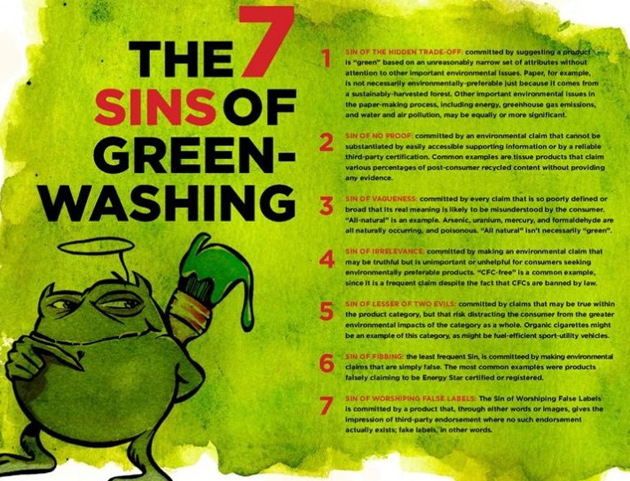
1. Sin of the hidden trade-off – advertising based on a narrow aspect of the product while not reporting its entire environmental impact.
2. Sin of no proof. If a product’s claims about being green can not be proven with easily accessed data.
3. Sin of Vagueness – Green claims so poorly defined you can’t follow up and prove it.
4. Sin of Irrelevance – Green marketing about environmental improvements may be true, but their impact is so margin that it makes no sense or is already required by law. (CFC-free is the example they use; it’s irrelevant since CFCs are outlawed.)
5. Sin of less of two evils. Environmental claims that a product may be greener than another product in its category, but that simply distract consumers from the fact that the whole product category is just plain bad for the environment, like organic cigarettes.
6. Sin of fibbing. Right what it says it is. Terrachoice says this sin is pretty uncommon
7. Sin of worshipping false labels. Marketing and artwork that gives the impression of a third-party or green underwriter endorsement when the product does not, in fact, have the certification.
In the 2010 edition of its “Sins of Greenwashing” report, environmental marketing company TerraChoice found some form of greenwashing in more than 95% of consumer products labeled as “green.” The construction sector by itself fared only slightly better, with greenwashing evidence in close to 94% of eco-marketed products.
On a positive note, that 95% is an improvement over last year, in which only 2% of studied products were free of greenwashing (and only 1% in 2007).
The study examined close to 5,300 home and family care products, including building and construction, toys, office, housewares, and health and beauty. Each product’s environmental claims were weighed against guidelines from the FTC, the Competition Bureau of Canada, and the ISO 14021 standard for environmental labeling, and findings were organized and identified using TerraChoice’s “7 Sins of Greenwashing.”
According to the report, the number of green-identified products on the market today is 73% higher than just one year ago. “This is good news, and it shows that consumers are changing the world by demanding greener goods and that markets and manufacturers are taking note,” TerraChoice president Scott McDougall said in a statement.
The building and construction products sector experienced a significant shift in this area, with a whopping 108% increase in total green products offered. And along with its slightly higher number of legitimately marketed products (6%) versus the group as a whole, the construction segment also demonstrated improved use of legitimate standards, with 31.7% using genuine eco-labels such as Energy Star, Greenguard, UL Environment, and EcoLogo. (Usage of labels among the entire group, on the other hand, dropped to 19.8% of products.)
Still, a larger portion of construction products—40% of products compared to the study average of 27.4%—committed the “sin of the hidden trade-off,” i.e., focusing on one narrow attribute while ignoring others. The report found the most common single-benefit claims referred to “air quality,” “energy,” and “recycled content.”
Among other findings across all product categories in the study:
Big box retailers stock more green products and more products with legitimate green labels than smaller green boutique-style stores. “We find that consumers can trust big box stores to provide the best selection and integrity of ‘greener’ product claims,” the report said.
Eco certifications are helpful, but don’t completely prevent problems. Of products certified by an ISO 14024-based program, 30% were sin-free.
Unfortunately, the use of false labels also is increasing, by a rate of more than 5% from 2009 to 2010. “Ease of access to false, completely meaningless eco-labels has become almost comical,” TerraChoice said.
The “sin of no proof” also grew significantly, from 56.4% of products to 70.1%.
Greenwashing declines with experience, with greenwashing-free products to be five times greater in mature versus immature categories.
Overall, the study shows promising developments, but ultimately showcases how much improvement marketers still have to make to accurately and fairly describe green product claims that will in turn help build the trust of consumers.
“Green claims on home and family products are getting better, but the vast majority are still misleading,” the report stated. “If green demand is to create genuinely greener products, the environmental claims of those products must be true and transparent. This is why greenwashing is such a significant impediment to continued progress.”
To view the full report, click here.

